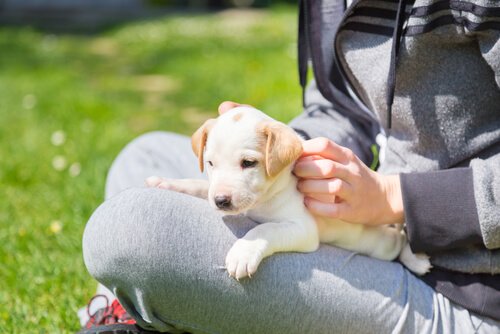10 Steps to Get Ready for Your Adopted Dog
4 minutes

If you have decided to adopt a dog from a shelter or are thinking of doing so, it’s important to keep in mind some things that can happen. The truth is that an adopted dog may be very overwhelmed when he gets to his new home.
You’ll want to know how the animal will react at home, on the street and with other people — and what to do about those reactions. You’ll need to treat your dog with patience and a lot of love.
Preparing for the arrival of your adopted dog

Before you take him home, make sure everything it set up so he’ll be comfortable when he gets to the house. Prepare the following things:
- The first thing is the bed. If he has spent some time in a cage, he’ll appreciate a comfortable place to rest. You can buy a bed or make it yourself. It’s better for it to be too big than to be too small.
- The second step will be to prepare his water bowl and food bowl with lots of fresh water and age-specific dog food. You’ll also need a toy or something he can chew on. This will be essential, since some dogs get anxiety and will have the urge to nibble.
- A collar and leash is essential, as well as bags to collect poop when you go for a walk with your new friend. Keep in mind that shelters tend to be financially strapped, and so it’s best for you to have everything your adopted dog will need.
- It’s also possible that he’ll be very dirty when he arrives. In that case, you should have shampoo and possibly a bath brush ready. You can also take your dog to a groomer and watch how they bathe him. Then copy the bathing process at home.
Home safety
- Make your home a safe place. Make sure, for example, that there are no toxic plants around and that they do not have direct access to the trash. Remove anything that you don’t want the dog to eat. Limit the newcomer’s space in the house. That way he won’t get overwhelmed.
- It is also a great idea to learn more about him. For example, what his past was like, if he’s afraid of the vet, and if he gets along with other dogs. It will help a lot to know your dog’s habits, personality, etc.
An adopted dog’s first days at home
- When you adopt a dog, it’s recommended to take him for a long walk on the way home. You can make sure he urinates and get him a little tired out. That way he’ll be more relaxed at home and if he tries to urinate, it will just be a bit.
- As soon as you enter your home with your new dog, untie him and let him sniff around the whole house, or at least the part of it that you want him to get to know. Avoid the kitchen for the time being, since it’s generally an unsafe area for pets. They’ll feel more restless there.
- It’s normal for the animal to mark his territory by urinating a little in some corners. It’s normal, especially if there have been other dogs at home.
Hyperactivity in adopted dogs

- The initial days can be somewhat stressful for an adopted dog and also for his owner. To help with his hyperactivity, and to prevent him from urinating in the house or other inappropriate places, take him out at least 4 times a day. Total walking time should add up to 90 minutes. It is a good idea to tire the animal out a little to lower his stress, because tension is common in newly adopted dogs. Also, feeling tired will help him sleep in his new home.
- Do not force him to interact with people or other dogs, or to lie down in certain places. Don’t do anything that might overwhelm him. Try to guide him towards obedience by using verbal communication, hand movements and rewards.
Order
Dogs are routine-oriented animals and they like order. Set a timetable for walks and meal times so that he can get used to it and feel comfortable. We may think it’s not important, but the truth is that it’s one of the most effective ways of helping your new furry friend get used to his new home.
